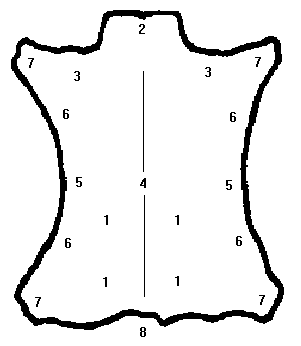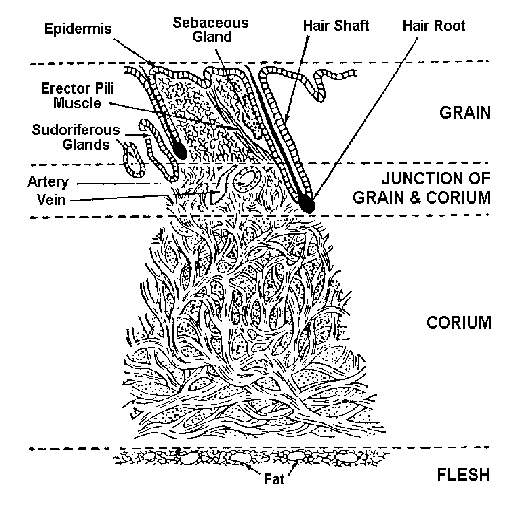
Volume 2 - Autumn 1996
The Manufacture of Leather - part 2
by David Lanning
 Here
is the second instalment on The Manufacture of Leather. In part 1, we covered
the brief history of leather, the various sources of the pelts we use, the
abattoir and the methods of preserving skins between the abattoir and tannery.
Here
is the second instalment on The Manufacture of Leather. In part 1, we covered
the brief history of leather, the various sources of the pelts we use, the
abattoir and the methods of preserving skins between the abattoir and tannery.
If you are reading this, I can only assume that you were not put off by the first article in this series. This instalment on the exciting world of leather manufacture, will cover the various processes undertaken by us to prepare the skins for tanning.
The Structure of Skins
Different parts of the skin have different names: 1 - The Butt - is the thickest and strongest part of the animal and normally provides the best quality leather 2 - The Neck - is thick and strong but provides a poorer cut due to creases and growth marks 3 - The Shoulder - is thinner and weaker than the butt or neck 4 - The Backbone - tends to be thinner than the butt area 5 - The Belly - is thin and has a less dense structure 6 - The Flanks - are the thinnest and weakest part of the skin 7 - The Shanks and 8 - Tail end
Follicle - The skin is full of pore holes which penetrate into the skin. These are called follicles. In pigskin, they penetrate deep into the lower flesh area, and as a result when you look at the reverse side of a pigskin, you can see the pore holes.
Hair/Wool - This grows in the skin through the follicle.
Hair Root - This lies at the bottom of the follicle.
Erector Pili Muscles - These muscles raises the hair on living animals and cause goose pimples.
Glands - The sebaceous glands secrete oils which lubricate the skin and hair. The sudoriferous glands exude sweat which is important in regulating the temperature of the skin and hence the animal.
Epidermis - The surface layer is called the epidermis. It consists of mainly dead cells which are relatively hard.
 The
hair/wool - The hair root and the epidermis are made from a protein called
keratin. It is the most stable part of the skin, but has to be removed during
manufacture, to expose the grain layer which lies beneath it.
The
hair/wool - The hair root and the epidermis are made from a protein called
keratin. It is the most stable part of the skin, but has to be removed during
manufacture, to expose the grain layer which lies beneath it.
Flesh - This deep layer is called the flesh layer. It contains high levels of meat and fat and is therefore of no use to the tanner.
Unless the leather is to be left with the hair on, as in the case of wooled sheepskin, it is the section between the epidermis and the flesh layer which is important to J. Hewit & Sons as tanners. This important section is called the dermis and consists mainly of densely interwoven fibrous tissue. This tissue is made up of a protein called collagen. If you look under a microscope, you will clearly see all of the fibre bundles. It is these fibre bundles which make leather such a strong, flexible and unique material.
The dermis is broken down into 3 parts.
Corium - Here the fibre bundles are large and strong. They lie at varying angles to the grain layer above. This angle varies in different animals, but to some extent, the angle can be altered during the leather manufacturing process. This angle is known as the 'angle of weave' and it effects the physical properties of the leather. A lower angle of weave produces a softer, weaker and less elastic leather.
Grain - It consists of more densely woven fibre bundles, which have a much finer construction. Towards the top of this layer, next to the epidermis, the fibres are extremely fine and form the layer we call the grain.
Junction - This is the area between the corium and the grain layer. In certain animals it can cause problems, e.g. in sheep (basil) where splitting can occur along the junction area.There are a few other things worth noting:· Running throughout the skin are many veins and sweat glands.· Between the fibre bundles are inter-fibrillary proteins. These proteins can cause a problem. They are not like the collagen proteins which make up the fibre bundles. When they dry out, they form hard glues that clog up the leather. This would make the leather hard and inflexible.There are many fat cells within the corium. These can vary depending on:
-
the type of animal
-
the breed
-
the foodstuffs used
-
the time of year it was slaughtered
Fats are easy to remove, but in sheep the fat can be up to 30% of the weight of the skin and once removed can leave large empty spaces, which can make the leather feel empty
The Tannery
When the skins arrive at the tannery in their cured form, they would have to be examined, to check for obvious damage due to poor flaying or curing. At this stage it has been known for us to reject a batch of skins and to return them to their country of origin. However, it is extremely rare for us to have to do this.
We now have to prepare the skins prior to the tanning process commencing.
Soaking - The first operation is to soak the skins. There are two reasons for this:
-
To return the skins to the state they were in at slaughter, i.e. to reverse the curing process, and
-
To remove all the blood, dirt and dung.
This operation, as do most of the following operations involving chemicals, take place at Hewit's tannery inside large wooden drums.
Skins are counted into batches and then weighed. Each batch is put in a drum and processing starts by soaking in cold water to which detergent, salt and biocide are added. The drum is turned occasionally and the water is changed if it becomes heavily contaminated. The process is finished when the water remains clean, and the skins have been re-hydrated. The time taken for this process depends on the method of curing which was implemented at the abattoir. E.g. longer for dry cured skins (approximately 72 hours) and shorter for wet salted skins (approximately 18 hours). The whole process can be speeded up by one or more of several methods:1) Heating the water and 2) Adding enzymes.
But beware!!!!!!! Soaking must be done correctly otherwise the skins won't relax properly. If this were to happen, the penetration of chemicals in all of the following processes would be patchy, resulting in an inconsistent leather.
Liming - The cleaned skins still have their hair on. In the case of our leather, this must now be removed together with the hair roots and the epidermis, in order to expose the grain layer. Sodium sulphide or sodium hydrosulphide is added to the soaked skins. After an hour or so, these chemicals would have penetrated deeply into the hair and grain of the leather, causing the breakdown of the keratin, the main protein constituent of the hair and epidermis. Lime and caustic soda, strong alkalis are then added, enhancing the breakdown which actually dissolves the hair root and epidermis away. No damage due to liming is done to the collagen (dermis) part of the skin. Another effect of the liming process is to remove the inter fibrillary proteins. These are proteins similar to egg white which, if not removed, would harden like glue and make the leather as stiff as a board.
Lime also causes two important physical effects - Osmotic Swelling and Lyotropic Plumping.* The result of these effects is that the skin becomes swollen and engorged with water causing the fibre bundles to open up allowing for thorough penetration of the tanning materials at a later stage.
*Editor's note - The precise definitions of these terms are beyond the scope of this article (and its author). If anyone would like further details, however, I'm sure I can persuade someone from the tannery to write a long and boring article to pad-out a future issue of this 'rag'. Letters to the letter page please!!!
Washing - The skins are washed to remove excess lime and materials loosened during the previous stage.
Fleshing - The adhering fat and tissues on the underside of the skin form a significant barrier to the penetration of subsequent chemicals. Thus, removal of this 'flesh' at an early stage, is highly desirable. The fleshing operation not only removes flesh, but assists in relaxing the skins and it also aids in the removal of any remaining hair roots out of the skin. This procedure is carried out using a fleshing machine.
Fleshing can be carried out immediately after the soaking phase - when it is known as green fleshing. The advantage of this is that it allows for better penetration of chemicals during the liming process, but the big disadvantage is that it can lead to mechanical damage on the skin, because the skin has not been relaxed.
De-liming - The liming operation has made the skins very alkaline. In order to begin tanning, the alkalinity has to be lowered considerably. The chemical used for this is ammonium chloride. As the lime in the skin is neutralised by the ammonium chloride, the skin starts to de-swell. As a result, the inter fibrillary and keratin proteins which were destroyed during liming, are washed out of the skin.
Bating - Bating is carried out in order to soften the skin even further, through the enzymatic removal of muscle fibres. When it is finished, the grain will be smooth and relaxed. Traditionally, this was the most unpleasant part of producing leather since various animal dungs, mainly dog and chicken would have been used as the source of the enzymes. The digestive tracts of these animals are a rich source of the relevant enzymes. In more recent times the enzyme was extracted from pancreas of cattle and was readily available as a by-product of insulin production. Nowadays, this has been replaced by bacterial enzymes.
Scudding - This is the final process prior to the tanning starting. By placing the skins on a rounded board, and by running a rounded blunt knife over the grain, any remaining hair-root, skin pigmentation and surface fat are squeezed out of the skin. We are one of the last remaining tanneries in the U.K. who still undertakes this process by hand.
The images in this article are taken from the Leather Technician's Handbook by J.H. Sharphouse and are reproduced with the kind permission of the Leather Producers' Association.
